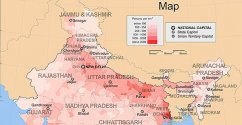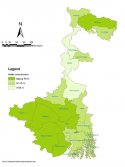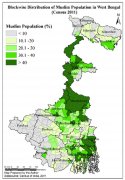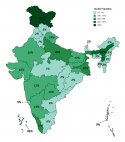My three rupees:
and
You're considering those numbers out of context:
- India - 1200k + 950k reserve
- Pakistan - 550k + 550k reserve
- Bangladesh - 250k + reserve
- Myanmar - 350k + reserve
- Nepal - 95k
- Bhutan - 9k
- China - 975k + reserve
China is geographically secure therefore it can afford to cut land force.
It has most of its population along the coast with western part of the country providing an extensive geographical buffer. It's main population centers are relatively safe from land attack in the north and south, India is separated by the Himalayas and the rest of the border is along sparsely populated territories.
India is geographically vulnerable.
In particular the eastern territories of can be cut off from the rest of India at a strategic chokepoint near Sikkim that is easily defensible.
View attachment 86919
It's a 20km wide strip of land 60km away from the border of Sikkim (and 80km from border with China) that can cut off the following states:
- Assam - 78k km2 + 31m pop.
- Tripura - 10k km2 + 3,6m pop.
- Meghalaya - 22k km2 + 3m pop.
- Manipur - 22k km2 + 2,6m pop.
- Nagaland - 16k km2 + 2m pop.
- Arunchal Pradesh - 84k km2 + 1,4m pop.
- Mizoram - 50k km2 + 1,1m pop.
- Sikkim - 7k km2 + 0,6m pop.
West Bengal (90m pop.) which is the state linking those states with the rest of India is politically split between BJP and more secular West Bengali AITC party which controls 75% of state legislature.
The cut-off area can then provide an attractive gain for neighboring countries drawing them into the conflict.
- Bangladesh - 148k km2 + 161m pop.
- Myanmar - 676k km2 + 53m pop.
Bangladesh is threatened by sea levels change which will affect population displacement without armed conflict. Banglades is former East Pakistan. Attitudes change with different circumstances.
A disaster scenario for India in three images:
1. Population density
View attachment 86910
2. Political identity
View attachment 86911
3. Poverty rate (numbers indicate poverty: 1- highest, 19-lowest)
View attachment 86912
A conflict with a rural Muslim insurgency in that chokepoint is the flashpoint. Bangladesh and Pakistan get involved with backing of China while Myanmar provides an independent pressure factor.
India's Muslim minority is over
170 million people. This is comparable to the populations of Muslim Pakistan and Bangladesh. This population is a recruitment pool for insurgencies.
View attachment 86920
Uttar Dinajpur is a land bridge between Nepal and Bangladesh which can become a
land bridge between Bangladesh and China. Money speaks loudest.
India ends up overstretched before real fighting even begins because it can't afford to weaken its western border. The border with Pakistan is one of the worst military theaters. India has to maintain at all times at least numerical parity to
defend itself and for any offensive operation it needs to have numerical superiority of 1,5-2:1 minimum. In 2050 Pakistan is projected to have population of 338m and growing compared to 220m in 2020 - 50% growth in 30 years. Such population growth has a different impact on mentality and willingness to accept casualties.
If India reduces its numbers even with an unlikely radical modernization of structure and doctrine it will be forced to move to deep strategic defensive for which it has no geographical buffer. It won't be able to project power reliably because of its geographical vulnerability as population doesn't matter if area can be captured with limited resources as demonstrated. Reduction of army numbers is possible but only at the cost of establishing a paramilitary formation with lower equipment cost. Therein lies the disastrous option of forming a political paramilitary by the BJP.
If India cuts numbers for economic reasons it is out of desperation, not rationalization.
-----------------
A few more rupees on light vs heavy fighters for India:
Using Russian and Chinese procurement as rational planning is incorrect.
Russia chose heavy fighters due to
internal politics. China chose heavy fighters based on strategic priorities of range and
availability of platform. Russia had no single-engine design at the time and MiG-29 had all-around worse performance than Su-27.
Both countries had no real aerial refueling capability at the time of decision which is the most important limiting factor in aerial operations.
Light fighters with aerial refueling are
always preferable to heavy fighters with no refueling because of logistics of production and maintenance. The fundamental problem of all aircraft is propulsion. Without it they can't fly and aircraft that can't fly are completely useless, unlike e.g. tanks or ships. With aerial refueling light fighters lose the disadvantage of range and maximum payload is not that important - it only requires a small number of aircraft capable of such weapons.
Heavy fighters are a product of the way in which technology evolved historically. They were necessary for energy as larger engines were required for altitude and speed - both fundamental for aerial combat using SARH missiles. SARH requires constant illumination of target which means that greater kinetic energy and more powerful radar were decisive factors. These favored heavy twin-engine fighters but technology made it no longer necessary.
- Desert Storm was won by F-16s and KC-135s
- Sweden planned for defense against USSR with Gripens
- PAF is going to gain an edge over IAF because of better fleet economy with JF-17
MKI was a vanity project without the necessary foundation and now it's an industrial burden.





